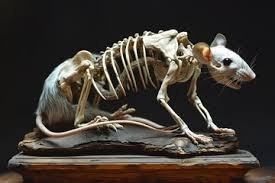Introduction: Tiny Intruders, Big Secrets
Spotting a mouse in your home can be alarming. A common question arises: do mice have bones? Many people assume they must have hollow bones to slip through gaps no wider than a pencil. This blog explores the truth behind this myth, revealing the anatomy that allows mice to navigate tight spaces, their role in scientific research, and practical tips for keeping your home mouse-free.

Image suggestion: Mouse squeezing through a small gap → Alt: “do mice have bones and how they fit through small openings”
The Myth vs. Reality: Do Mice Have Bones?
Debunking the Hollow Bones Myth
Mice do not have hollow bones. They are vertebrate mammals with a complete skeletal system, just like humans. Their bones are lightweight but strong, providing flexibility and support for rapid movement.
Mouse Skeletal Blueprint
Mice possess over 200 bones, similar to the 206 in adult humans. Their skeleton includes:
Skull
- Protects the brain and eyes.
- Divided into rostral (front) and caudal (rear) sections.
Spinal Column
- 7 cervical, 13 thoracic, 4–6 lumbar, and variable caudal vertebrae.
- Provides support and flexibility while protecting the spinal cord.
Ribs
- 13 pairs of ribs forming a flexible rib cage.
Pelvis and Limb Bones
- Enable climbing, running, and jumping.
Image suggestion: Diagram of mouse skeleton → Alt: “mouse skeleton showing do mice have bones”
How Mice Squeeze Through Tiny Spaces
Skull-First Entry
The largest rigid part of a mouse is its skull. Once the head fits through a gap, the body follows.
The Collarbone Conundrum
Despite myths, mice do have clavicles (collarbones). These allow for remarkable limb mobility while supporting climbing and standing on hind legs.
Tiny Openings
Mice can squeeze through gaps as small as ¼ inch, smaller than a nickel, demonstrating the importance of sealing even tiny cracks in your home.
Beyond Infestation: Mice as Scientific Marvels
Mouse Anatomy Studies: https://www.google.com/
Detailed anatomical studies, such as Margaret J. Cook’s 1965 research, revealed the mouse skeleton and internal organs. Recent efforts aim to standardize mouse anatomical terminology (mTA) for research consistency.
Mice in Human Disease Research
Mice are essential models for understanding osteoporosis, lissencephaly, and other conditions. Their anatomy often mirrors human biology, making discoveries in mice directly applicable to humans.
Cutting-Edge Tools
- Microcomputed tomography (µCT) allows high-resolution 3D imaging of mouse skeletons.
- Polymerizable resin injections and scanning electron microscopy clarify anatomical structures.
Image suggestion: µCT scan of mouse → Alt: “do mice have bones 3D scan of skeleton”
Practical Advice: Keeping Your Home Mouse-Free
Why Act Early
Mice pose risks including:
- Contamination: Food and surfaces.
- Property Damage: Chewing wires, insulation, and structures.
- Disease Transmission: Hantavirus, Salmonellosis, LCMV.
- Secondary Pests: Fleas and ticks.
Prevention (Exclusion)
- Seal all gaps larger than ¼ inch with caulk, expanding foam, or cement.
- Store food in airtight containers and maintain cleanliness.
- Reduce shrubs and hiding spots around the house.
Understanding Behavior
- Nocturnal: Most activity occurs at night.
- Daytime Sightings: Often indicate a larger infestation.
- Cats Are Not Enough: Alone, pets cannot control populations effectively.
When to Call Professionals
If DIY exclusion fails, pest control experts can identify hidden entry points and implement tailored solutions.
Conclusion: A Small Creature with a Big Impact
Mice are not hollow-boned creatures. Their ability to enter small spaces is dictated by their skull size, flexibility, and strong incisors. Beyond being pests, mice are scientific models that advance our understanding of human biology.




